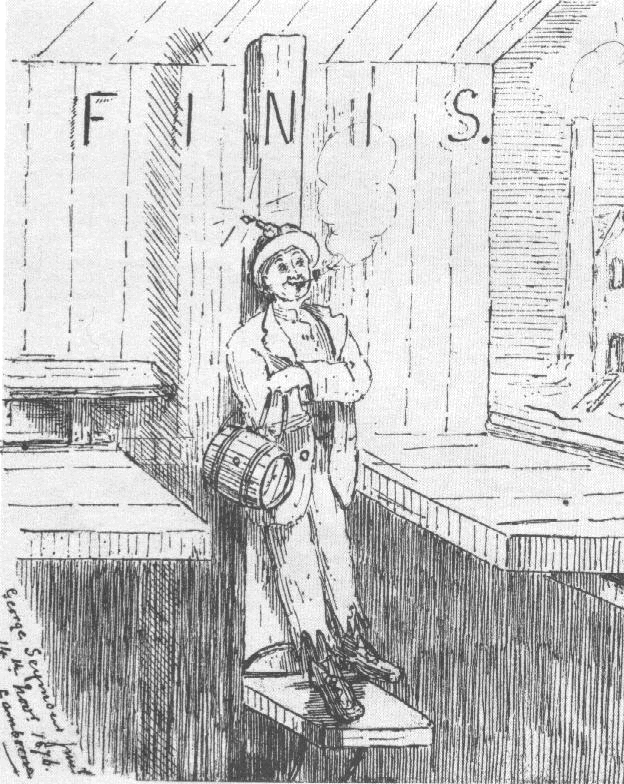The Cornish Man Engine
![]()
The Man Engine
A mechanical lift for lowering and raising miners in a shaft by means of a reciprocating vertical rod of heavy timber with platforms at intervals, or of two such rods, moving in opposite directions. In the former case stationary platforms are placed in the shaft, so that the miner in descending for instance, can step from the moving platform at the end of the down stroke and step back upon the next platform below at the beginning of the next down stroke. When two rods are employed, the miner steps from the platform on one rod to that on the other.
To see a working graphic of the engine click here
Cost of Man-Engine.
The cost of a man-engine, with driving engine, complete to a depth of 200 fathoms, exclusive of the cost of the shaft itself, cannot be taken at less than £2000 to £2500. The interest on the larger sum at 5 per cent., with 10 per cent. added for depreciation of plant and repairs, amounts to £375 per annum. The cost of coal and attendance for driving the engine, for oil, grease, etc., will amount to, say, £250 per annum in addition. The labour of climbing from an average depth of 100 fathoms cannot be taken at less than 1 hour daily, or, with 3 shifts of 50 men at an average of .5d., the amount lost by climbing will be each day 62s. 6d. ; or, for a year of 260 working (lays, say, £800, showing a clear gain of £175. For a depth of 300 fathoms the advantage is many times greater, since the. exhaustion of the men from the labour of climbing and the time occupied will increase in a geometrical ratio. However, setting aside all calculations of cost, it is only necessary to look at the men 'who have just come up by ladders from deep mines to see that some mode of relieving them from such excessive toil is most necessary.
The man-engine originated in Germany, where it is called the "fahr-kunst." The idea occurred to some of the German miners, who saw the reciprocating action of the pump rods, to attach steps to it, and this was actually carried into practice. In Cornwall the idea of a man-engine was first carried into effect by Mr. Loam, in 1835, at Tresavean Mine in Gwennap. The man-engine was so great an advantage to all concerned both workmen and employers -that it would soon have become generally used in deep mines but for its great expense. But the improvements in the manufacture of wire rope within the past 25 years have been so great, that the chief danger in connection with the use of lifting-cages or skips has now disappeared. And the cost of putting in a " skip way," as well as of working the skip, is far less than that of erecting and working a man-engine, so that it is hardly likely any more will be erected.
From "Principles of Metal Mining" by J.H. Collins FGS

(From Glossary of Mining Terms by Rossiter W. Raymond, 1881)
Michael Loam: The Engineer
Gravestone of Michael Loam in Gwennap Church burial ground.
The first Cornish Man Engine was built at the Tresavean mine in Gwennap Parish in 1842 by Michael Loam the Tresavean Mine Engineer. Loam, adapted the German design to win a competition sponsored by the Royal Cornwall Polytechnic Society of Falmouth in 1933. Two years later the Tresavean engine was ready to begin its trials with the engine reaching a depth of 24 fathoms. After a successful trial period the Mine's Directors gave the go a-head to extend down to the 248 fathom level. This was the first of 16 such engines to be built in Cornwall.
Michael
Loam, the inventor or developer of the Man Engine was born on the 1st of
November 1797 at Ludgvan, Cornwall. He married Charity Rowe of Crowan, and later
Margaret Skews/Bray. He died at Moditonham, the home of his son Matthew Loam in
Botus Fleming, on the 14th July 1871 and was buried in Gwennap churchyard. Above
is a photo of his gravestone.
Cornish Newspaper Reports on Man Engines:
Available at the Cornwall Studies Centre, Redruth
Royal Cornwall Gazette: 24.11.1837 / 6.4.1838 / 31.12.1841 / 7.10.1842 / 21.10.1842 / 6.1.1843
West Briton: 5.10.1838 / 19.10.1838 / 13.9.1839 / 11.10.1839 / 25.10.1839 / 15.11.1839 / 14.1.1842 / 11.2.1842 / 18.11.1842 / 6.1.1843 /
Penzance Gazette: 19.7.1843 / 4.10.1843 / 3.7.1844 / 25.12. 1844 / 19.2. 1845 / 21.1. 1846